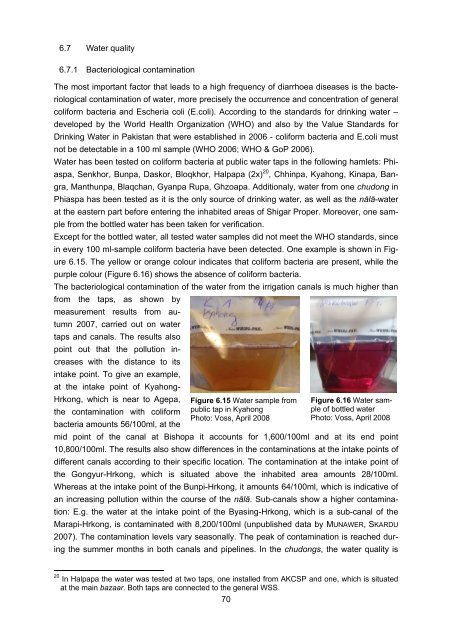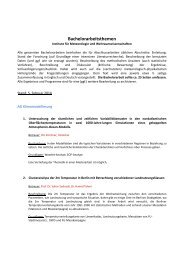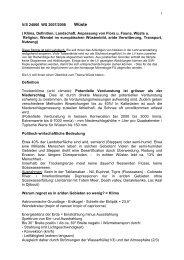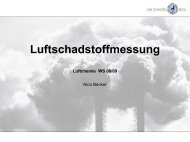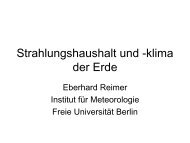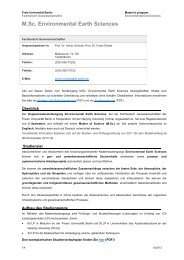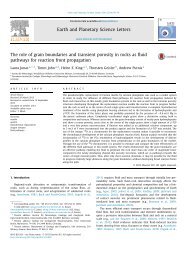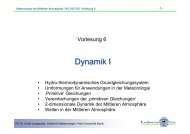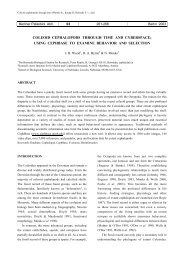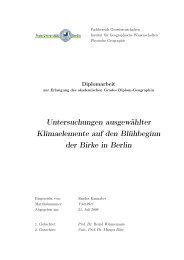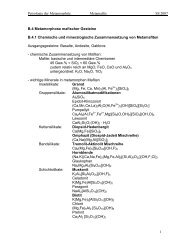Map 3.1 Shigar Oasis - Freie Universität Berlin
Map 3.1 Shigar Oasis - Freie Universität Berlin
Map 3.1 Shigar Oasis - Freie Universität Berlin
Create successful ePaper yourself
Turn your PDF publications into a flip-book with our unique Google optimized e-Paper software.
6.7 Water quality<br />
6.7.1 Bacteriological contamination<br />
The most important factor that leads to a high frequency of diarrhoea diseases is the bacteriological<br />
contamination of water, more precisely the occurrence and concentration of general<br />
coliform bacteria and Escheria coli (E.coli). According to the standards for drinking water –<br />
developed by the World Health Organization (WHO) and also by the Value Standards for<br />
Drinking Water in Pakistan that were established in 2006 - coliform bacteria and E.coli must<br />
not be detectable in a 100 ml sample (WHO 2006; WHO & GoP 2006).<br />
Water has been tested on coliform bacteria at public water taps in the following hamlets: Phiaspa,<br />
Senkhor, Bunpa, Daskor, Bloqkhor, Halpapa (2x) 20 , Chhinpa, Kyahong, Kinapa, Bangra,<br />
Manthunpa, Blaqchan, Gyanpa Rupa, Ghzoapa. Additionaly, water from one chudong in<br />
Phiaspa has been tested as it is the only source of drinking water, as well as the nālā-water<br />
at the eastern part before entering the inhabited areas of <strong>Shigar</strong> Proper. Moreover, one sample<br />
from the bottled water has been taken for verification.<br />
Except for the bottled water, all tested water samples did not meet the WHO standards, since<br />
in every 100 ml-sample coliform bacteria have been detected. One example is shown in Figure<br />
6.15. The yellow or orange colour indicates that coliform bacteria are present, while the<br />
purple colour (Figure 6.16) shows the absence of coliform bacteria.<br />
The bacteriological contamination of the water from the irrigation canals is much higher than<br />
from the taps, as shown by<br />
measurement results from autumn<br />
2007, carried out on water<br />
taps and canals. The results also<br />
point out that the pollution increases<br />
with the distance to its<br />
intake point. To give an example,<br />
at the intake point of Kyahong-<br />
Hrkong, which is near to Agepa, Figure 6.15 Water sample from Figure 6.16 Water sam-<br />
the contamination with coliform public tap in Kyahong<br />
ple of bottled water<br />
Photo: Voss, April 2008<br />
Photo: Voss, April 2008<br />
bacteria amounts 56/100ml, at the<br />
mid point of the canal at Bishopa it accounts for 1,600/100ml and at its end point<br />
10,800/100ml. The results also show differences in the contaminations at the intake points of<br />
different canals according to their specific location. The contamination at the intake point of<br />
the Gongyur-Hrkong, which is situated above the inhabited area amounts 28/100ml.<br />
Whereas at the intake point of the Bunpi-Hrkong, it amounts 64/100ml, which is indicative of<br />
an increasing pollution within the course of the nālā. Sub-canals show a higher contamination:<br />
E.g. the water at the intake point of the Byasing-Hrkong, which is a sub-canal of the<br />
Marapi-Hrkong, is contaminated with 8,200/100ml (unpublished data by MUNAWER, SKARDU<br />
2007). The contamination levels vary seasonally. The peak of contamination is reached during<br />
the summer months in both canals and pipelines. In the chudongs, the water quality is<br />
20<br />
In Halpapa the water was tested at two taps, one installed from AKCSP and one, which is situated<br />
at the main bazaar. Both taps are connected to the general WSS.<br />
70


